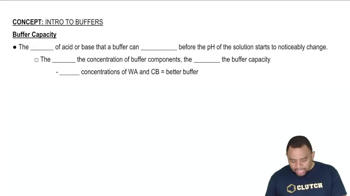Which buffer system is the best choice to create a buffer with pH = 9.00? For the best system, calculate the ratio of the masses of the buffer components required to make the buffer. HF/KF HNO2/KNO2 NH3/NH4Cl HClO/KClO
Ch.17 - Aqueous Ionic Equilibrium
Chapter 17, Problem 59b
A 500.0-mL buffer solution is 0.100 M in HNO2 and 0.150 M in KNO2. Determine if each addition would exceed the capacity of the buffer to neutralize it. b. 350 mg KOH
 Verified step by step guidance
Verified step by step guidance1
Convert the mass of KOH to moles by using its molar mass. The molar mass of KOH is approximately 56.11 g/mol.
Calculate the moles of HNO_2 in the buffer solution using its concentration and volume. Use the formula: moles = concentration (M) × volume (L).
Calculate the moles of KNO_2 in the buffer solution using its concentration and volume. Use the formula: moles = concentration (M) × volume (L).
Determine the buffer capacity by comparing the moles of KOH to the moles of HNO_2 and KNO_2. A buffer can neutralize added acid or base as long as the moles of added substance do not exceed the moles of the buffer components.
Assess if the moles of KOH exceed the buffer capacity. If the moles of KOH are less than or equal to the moles of HNO_2 and KNO_2, the buffer can neutralize the addition. Otherwise, it exceeds the buffer capacity.

Verified video answer for a similar problem:
This video solution was recommended by our tutors as helpful for the problem above.
Video duration:
3mWas this helpful?
Key Concepts
Here are the essential concepts you must grasp in order to answer the question correctly.
Buffer Solutions
Buffer solutions are mixtures that resist changes in pH when small amounts of acid or base are added. They typically consist of a weak acid and its conjugate base or a weak base and its conjugate acid. In this case, HNO2 is the weak acid, and KNO2 provides the conjugate base, allowing the solution to maintain a stable pH despite the addition of KOH.
Recommended video:
Guided course

Buffer Solutions
Buffer Capacity
Buffer capacity refers to the amount of acid or base that a buffer can neutralize before a significant change in pH occurs. It is influenced by the concentrations of the acid and base components in the buffer. The greater the concentrations, the higher the buffer capacity, meaning it can neutralize more added acid or base without exceeding its limits.
Recommended video:
Guided course

Buffer Capacity
Stoichiometry of Neutralization Reactions
Stoichiometry involves the calculation of reactants and products in chemical reactions. In the context of buffer solutions, it is essential to determine how much of the buffer components will react with the added KOH. The neutralization reaction between KOH (a strong base) and HNO2 (a weak acid) will dictate whether the buffer can effectively neutralize the added base without exceeding its capacity.
Recommended video:
Guided course

Stoichiometry Concept
Related Practice
Textbook Question
Textbook Question
A 500.0-mL buffer solution is 0.100 M in HNO2 and 0.150 M in KNO2. Determine if each addition would exceed the capacity of the buffer to neutralize it. a. 250 mg NaOH
Textbook Question
A 500.0-mL buffer solution is 0.100 M in HNO2 and 0.150 M in KNO2. Determine if each addition would exceed the capacity of the buffer to neutralize it. c. 1.25 g HBr
Textbook Question
A 500.0-mL buffer solution is 0.100 M in HNO2 and 0.150 M in KNO2. Determine if each addition would exceed the capacity of the buffer to neutralize it. d. 1.35 g HI
Textbook Question
A 1.0-L buffer solution is 0.125 M in HNO2 and 0.145 M in NaNO2. Determine the concentrations of HNO2 and NaNO2 after the addition of each substance: a. 1.5 g HCl b. 1.5 g NaOH c. 1.5 g HI
1
views
